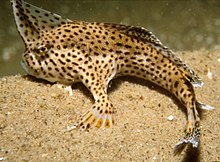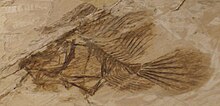Handfish
| Handfish | |
|---|---|

| |
| Brachionichthys hirsutus | |
| Scientific classification | |
| Domain: | Eukaryota |
| Kingdom: | Animalia |
| Phylum: | Chordata |
| Class: | Actinopterygii |
| Order: | Lophiiformes |
| Suborder: | Antennarioidei |
| Family: | Brachionichthyidae T. N. Gill, 1878 |
| Genera | |
|
Brachionichthys | |
Handfish are any anglerfish within the family Brachionichthyidae, a group which comprises five genera and 14 extant species.[2] These benthic marine fish are unusual in the way they propel themselves by walking on the sea floor rather than swimming.
Distribution
Handfish are found today in the coastal waters of southern and eastern Australia and around the island state of Tasmania. This is the most species-rich of the few marine fish families endemic to the Australian region, with all but three species found there.[3] There are 14 species of handfish around Tasmania.[4]
The biology of handfishes is poorly known and their typically small population sizes and restricted distributions make them highly vulnerable to disturbance. Some species are considered to be critically endangered.[5]
Anatomy
Handfish grow up to 15 cm (5.9 in) long, and have skin covered with denticles (tooth-like scales), giving them the alternative name warty anglers. They are slow-moving fish that prefer to 'walk' rather than swim, using their modified pectoral fins to move about on the sea floor. These highly modified fins have the appearance of hands, hence their scientific name, from Latin bracchium meaning "arm" and Greek ichthys meaning "fish".[citation needed]
Like other anglerfish, they possess an illicium, a modified dorsal fin ray above the mouth, but it is short and does not appear to be used as a fishing lure.[dubious – discuss][1] The second dorsal spine is joined to the third by a flap of skin, making a crest.[6]
Fossil record

The prehistoric species, Histionotophorus bassani, from the Lutetian of Monte Bolca, is now considered to be a handfish, sometimes even being included in the genus Brachionichthys. Considering the low extant diversity, restricted geographical distribution, and very meagre fossil record of antennarioids in general, the existence of fossil representatives of the family Brachionichthyidae is unusual.[5]
Conservation status



In 1996, the spotted handfish (Brachionichthys hirsutus) was the first marine fish to be listed as critically endangered in the IUCN Red List.[7][8] With its only habitat in the Derwent River estuary and surrounds, it is threatened by the Northern Pacific seastar's invasion into southern Australian waters. The Northern Pacific seastar (Asterias amurensis), preys on not only the fish eggs,[9] but also on the sea squirts (ascidians)[10] that help to form the substrate that the fish spawn on.[11]
The cause of the decline in spotted handfish is unclear. Suggested causes may include disturbance of benthic communities and predation on egg masses by the introduced northern Pacific seastar, habitat modification through increased siltation, heavy metal contamination or urban effluent. The lack of a pelagic larval stage and low rates of dispersal may be responsible for their restricted distributions and may also have an impact on handfishes ability to recolonise areas where they once occurred.[3]
In March 2020, the smooth handfish (Sympterichthys unipennis) was declared extinct in the IUCN Red List.[12][7] Once common enough to be one of the first fish to be described by European explorers of Australia, but not seen for well over a century, this is the first modern-day marine fish to be officially declared extinct.[7] However, this was reversed in September 2021, as there is not sufficient data to confirm this status.[13][14]
In October 2021, the endangered and very rare pink handfish (Brachiopsilus dianthus[15]) was seen for the first time since 1999, in footage from a camera placed on the sea bed off Tasmania at a depth of 150 m (490 ft). Prior to this sighting, it had been assumed that this species was confined to shallow waters. The discovery that it has a greater range than previously thought may give cause for optimism regarding its survival.[4]
Current status of species
As of December 2021[update] three species of handfish are listed as threatened under the Environment Protection and Biodiversity Conservation Act 1999 (EPBC Act) and the IUCN:[3]
- Brachionichthys hirsutus, spotted handfish – Critically Endangered under EPBC Act and IUCN;[16]
- Thymichthys politus,[a] red handfish – Critically Endangered under EPBC Act and IUCN;[17] and
- Brachiopsilus ziebelli, Ziebell's handfish – Vulnerable under EPBC Act, Critically Endangered under IUCN.[18]
All three of the above are listed as Endangered under the Tasmanian Threatened Species Protection Act 1995,[16][17][18] and all handfish species are protected under the Tasmanian Living Marine Resources Management Act 1995, which prohibits their collection in State waters without a permit.[3]
Footnotes
- ^ Fishes of Australia says Brachionichthys politus, red handfish, and it appears from the Australian Govt Species Profile and Threats Database that there has been a change of name from this name to the current one around 2011, with the EPBC Act updated accordingly.[17]
References
- ^ Sepkoski, Jack (2002). "A compendium of fossil marine animal genera". Bulletins of American Paleontology. 364: 560. Archived from the original on 30 April 2008.
- ^ Last, P.R.; Gledhill, D.C. (2009). "A revision of the Australian handfishes (Lophiiformes: Brachionichthyidae), with descriptions of three new genera and nine new species" (PDF). Zootaxa. 2252: 1–77. doi:10.11646/zootaxa.2252.1.1.
- ^ a b c d "Family Brachionichthyidae". Fishes of Australia. Museums Victoria. Retrieved 29 December 2021. Text may have been copied from this source, which is available under a
 Attribution 3.0 Australia (CC BY 3.0 AU) licence.
Attribution 3.0 Australia (CC BY 3.0 AU) licence.
- ^ a b "Rare pink handfish spotted in Australia for first time in decades". BBC News. 24 December 2021.
- ^ a b Carnevale, Giorgio; Pietsch, Theodore W. (2010). "Eocene handfishes from Monte Bolca, with description of a new genus and species, and a phylogeny of the family Brachionichthyidae (Teleostei: Lophiiformes)". Zoological Journal of the Linnean Society. 160 (4): 621–647. doi:10.1111/j.1096-3642.2009.00623.x.
- ^ Pietsch, Theodore W. (2005). "Brachionichthyidae". Tree of Life web project. Retrieved 4 April 2006.
- ^ a b c Shiffman, David (July 2020). "Smooth Handfish Extinction Marks a Sad Milestone". Scientific American. 323 (1): 14.
- ^ Edgar, G., Stuart-Smith, R. & Last, P.R. (2020). Brachionichthys hirsutus. The IUCN Red List of Threatened Species. doi:10.2305/IUCN.UK.2020-1.RLTS.T2958A121210485.en
- ^ "Brachionichtys-hirsutus". Fishbase.
- ^ "Asterias amurensis". Global invasive species database. Invasive Species Specialist Group (ISSG). 10 March 2010. Retrieved 20 February 2021.
- ^ MacDonald, Lucy (20 February 2021). "Volunteers hope efforts to remove invasive northern Pacific seastar will make a difference". ABC News. Australian Broadcasting Corporation. Retrieved 20 February 2021.
- ^ Last, P.R., Edgar, G. & Stuart-Smith, R. (2020). Sympterichthys unipennis. The IUCN Red List of Threatened Species. doi:10.2305/IUCN.UK.2020-1.RLTS.T123423283A123424374.en
- ^ Clarke, Melissa (9 December 2021). "Bogong moth, grey-headed flying fox listed as endangered by IUCN". ABC News. Australian Broadcasting Corporation. Retrieved 30 December 2021.
- ^ "The IUCN Red List of Threatened Species". IUCN Red List of Threatened Species. 9 September 2021. Retrieved 30 December 2021.
- ^ "Pink Handfish, Brachiopsilus dianthus Last & Gledhill 2009". Fishes of Australia. Museums Victoria. Retrieved 29 December 2021.
 Attribution 3.0 Australia (CC BY 3.0 AU) licence.
Attribution 3.0 Australia (CC BY 3.0 AU) licence.
- ^ a b "Brachionichthys hirsutus — Spotted Handfish". Species Profile and Threats Database. SPRAT Profile. Department of Agriculture, Water and the Environment (Australia). Retrieved 30 December 2021.
 Attribution 4.0 International (CC BY 4.0) licence.
Attribution 4.0 International (CC BY 4.0) licence.
- ^ a b c "Thymichthys politus - Red Handfish". Species Profile and Threats Database. SPRAT Profile. Department of Agriculture, Water and the Environment (Australia). Retrieved 30 December 2021.
 Attribution 4.0 International (CC BY 4.0) licence.
Attribution 4.0 International (CC BY 4.0) licence.
- ^ a b "Brachiopsilus ziebelli — Ziebell's Handfish, Waterfall Bay Handfish". Species Profile and Threats Database. SPRAT Profile. Department of Agriculture, Water and the Environment (Australia). Retrieved 30 December 2021.
 Attribution 4.0 International (CC BY 4.0) licence.
Attribution 4.0 International (CC BY 4.0) licence.
External links
- Bradley, Carolyn. Pictures: Nine Fish With "Hands" Found to Be New Species (National Geographic, 25 May 2010) - Pink handfish formally identified.
